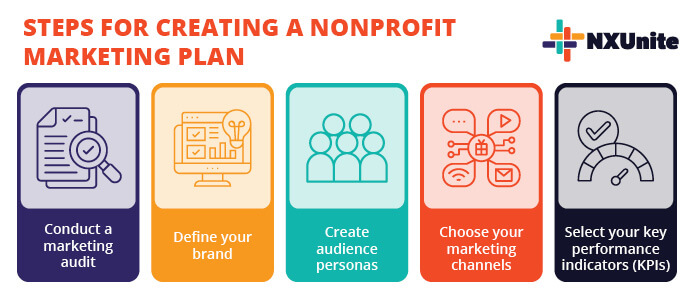Nonprofit Marketing Plan – Nonprofit Catalog
Nonprofits are challenged to do more with less. For marketers in particular, you’re tasked with finding the proper channels and developing powerful messages to amplify your organization’s work — all while battling limited resources. A formal nonprofit marketing plan gives you clear guidance on achieving that.
We’ll look at the components of a nonprofit marketing plan, giving you exact steps for outlining your own. You’ll have everything you need to develop a holistic marketing strategy. That way, you can form and cultivate meaningful supporter relationships through efficient communication.
What Is A Nonprofit Marketing Plan?
A nonprofit marketing plan is a document that outlines the promotional channels, strategies, and metrics your team will use to spread your mission. This document acts as a roadmap for promoting your initiatives. It provides specific branding guidelines to ensure every piece of marketing collateral is consistent and accurately reflects your organization.
Everyone working at the organization should have access to your nonprofit marketing plan. This allows them to refer to your objectives and align their activities accordingly.
How to Create a Nonprofit Marketing Plan
Especially if you’re a smaller organization, you’re up against established organizations. In other words, you have to go above and beyond to stand out and strengthen brand awareness. So let’s look at five key steps you should take when crafting your nonprofit marketing plan.

1. Conduct a marketing audit.
Unless you’re just now launching your nonprofit, you likely already have marketing experience. That means you have a foundation to build off. Start crafting your nonprofit marketing plan by assessing your past campaigns. Getting Attention’s nonprofit marketing plan guide suggests that you answer questions such as:
- Did you achieve the goals you set? If not, how far short did you fall?
- What platforms did you use?
- What key performance metrics (KPIs) did you track? Did they accurately gauge success?
- What strategies should you use again, and what should you do differently next time?
- Can you reuse any of the marketing materials for future campaigns?
These questions will help you understand where you’re currently excelling and falling short with your marketing efforts.
2. Define your brand.
You’ll want to create a brand style guide as part of your nonprofit marketing plan. This will keep your marketing assets consistent, helping to establish your brand identity. Define elements such as your:
- Narrative and voice: Ask yourself what you want your nonprofit to be known for. Do you want to come across as a warm and compassionate nonprofit that provides families with a haven in their time of need? Or maybe you want to come across as a headstrong, no-nonsense team that will fight for families when they need it most. Choose your narrative and a voice that communicates that.
- Colors: Kwala’s nonprofit branding guide explains that most organizations use 2-3 colors, including one primary color and one or two neutral accent colors. Think carefully about what colors are associated with your cause and will elicit the appropriate emotions. For instance, red can symbolize urgency and is commonly used with health and humanitarian relief organizations.
- Typography: You’ll want to select specific fonts to use in your marketing materials and define in which contexts to use each one. Similar to colors, different fonts elicit different emotions depending on whether they look more playful or sophisticated.
Staying consistent will help supporters remember your brand, making it easier for them to recognize your marketing materials.
3. Define your audience.
Knowing who you’re trying to reach with your promotional materials will help you choose the right channels and messages for them. Based on your current audience, create personas that explain your typical supporters’:
- Age range
- Traits and motivations
- Preferred communication methods
- Giving preferences
Ideally, you’ll want to create a persona for your average donor, volunteer, advocate, and other supporters. Doing so will empower you to craft messages that resonate with different groups of people more meaningfully.
4. Choose your marketing channels.
Once you know who you’re trying to reach, figure out how you’ll reach them. Your nonprofit marketing plan should define the channels you’ll use to spread your message. While there are plenty out there to choose from, here are a few common ones you might employ:
- Social media. A share button is a powerful tool. Determine which platforms your audience actively uses. Within your nonprofit marketing plan, lay out which platforms your marketing team should use and the types of messages that should be shared on each one. You’ll also want to set ground rules for interacting with followers. If you’re crafting a plan for a specific campaign, you can even include a posting schedule.
- Google Ad Grants and Microsoft Grants. Paid search engine marketing is a powerful tool. Programs like Microsoft Ad Grants and Google Grants provide these typically-expensive resources to nonprofits free of charge. Through these programs, you’ll receive free funding to spend on paid search ads and amplify content from your website.
- Direct mail. An awful lot of people still prefer handwritten postcards and letters. It provides a personal touch that can’t be replicated in the digital space. Include guidelines for what types of outreach you’ll send via direct mail, such as thank-you letters, campaign flyers, and project brochures.
- Email. This is a go-to platform for nonprofit marketers because it lets you simultaneously connect with all types of supporters. Plus, most email marketing platforms allow you to segment your email lists, so you can craft more personalized outreach for each type of supporter. Define guidelines for your newsletter and any other outreach you’ll send via email.
With the expanding digital marketing space, the list of marketing platforms never stops growing! And while you’ll certainly want to use multiple channels, be selective in the ones you choose. Otherwise, you risk spreading yourself too thin. Instead of posting the same generic appeal across all platforms, you’ll need to adjust your messages based on each platform.
5. Select key performance indicators.
Your nonprofit marketing plan isn’t quite complete yet! You should include which KPIs you’ll use to measure your success. Note that you’ll want to break down your nonprofit’s metrics for each platform. Here are some common ones you might include:
- Conversions. This is the number of desired actions someone takes to support your work. Great for any platform, this metric might include donations, volunteer registrations, or email newsletter sign-ups.
- Click-through rate (CTR). Specific to search engine ads and email marketing, your CTR measures the ratio of users who click a specific link to the total number of users who viewed it.
- Social media engagement. Get specific with these metrics by monitoring your likes, shares, and comments. Some social media platforms will even provide you with additional metrics like impressions to gauge your digital reach.
Tracking the right analytics will take the guesswork out of your performance. In your nonprofit marketing plan, list out the exact metrics you want to monitor, so you’re not scrambling to correct your strategies if your outreach underperforms.
Additional Resources
Nonprofit Catalog – Read up on more nonprofit essentials by exploring our Nonprofit Catalog.
Nonprofit Marketing Ideas: Promote Your Cause Effectively – Dive into the basics of nonprofit marketing and learn unique strategies for promoting your mission with this guide.
40+ Marketing Ideas for Nonprofits to Spread Your Mission – Fold these ideas into your strategies and create a more robust nonprofit marketing plan.


